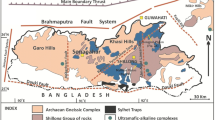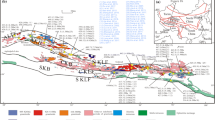Abstract.
Miocene extension in the Aegean Sea was accompanied by the intrusion of granitoid and monzonitic magmas at upper crustal levels. With increasing distance from the trench, the metaluminous to slightly peraluminous I-type intrusives show a systematic regional variation in their compositions: medium- to high-K granodiorites in the WSW, high-K low-silica granites in the central region and high-K high-silica granites, monzonites, monzogranites and composite lamprophyric-monzonitic dikes in the ENE. The granodioritic and low-silica granitic plutons comprise similar ranges of SiO2 (63.5–71.6 wt%) and initial Nd–Sr and O isotopic values [εNd(I)=–7.0 to –9.8; 87Sr/86Sr(I)=0.7092–0.7115; δ18O=9.7–11.5‰], but display significant differences in their chemical compositions. Compared with the granodiorites, the low-silica granites have higher abundances of large ion lithophile, light rare earth and some high-field strength elements. Initial isotopic signatures of the high-silica granites in the ENE [εNd(I)=–9.0 to –9.6; 87Sr/86Sr(I)=0.7128–0.7144; δ18O=10.8–12.0‰] are slightly more 'crust-like' than those of the low-silica granites. In chemical variation diagrams, samples from the high-silica granites continue the trends defined by those from the low-silica granites. It is suggested that all granitoid magmas originated by dehydration melting of metaluminous older crustal sources, most probably metagreywackes. U–Pb systematics of zircon populations in conjunction with Zr–SiO2 systematics and zircon saturation temperatures suggest a high proportion of restitic or assimilated crustal material in these magmas. Monzonitic to monzogranitic rocks show chemical and isotopic characteristics [εNd(I)=–0.8 to –3.6; 87Sr/86Sr(I)=0.7059–0.7071; δ18O=9.4–10.6‰] that are significantly different from those of the granitoids. A small portion of an older crustal component in these magmas is indicated by U–Pb systematics of zircon populations. Lamprophyric dikes display chemical and isotopic signatures [εNd(I)≈+0.5; 87Sr/86Sr(I)≈0.7044; δ18O≈8.9‰] that are compatible with an origin from either a mantle source previously enriched by slab-derived hydrous fluids/melts as suggested by negative Nb–Ta anomalies or a new K-rich basaltic underplate. Abundant composite dikes indicate the coexistence of and mingling/mixing between lamprophyric melts and monzonitic magmas.
Similar content being viewed by others
Author information
Authors and Affiliations
Additional information
Electronic Publication
Rights and permissions
About this article
Cite this article
Altherr, R., Siebel, W. I-type plutonism in a continental back-arc setting: Miocene granitoids and monzonites from the central Aegean Sea, Greece. Contrib Mineral Petrol 143, 397–415 (2002). https://doi.org/10.1007/s00410-002-0352-y
Received:
Accepted:
Issue Date:
DOI: https://doi.org/10.1007/s00410-002-0352-y




